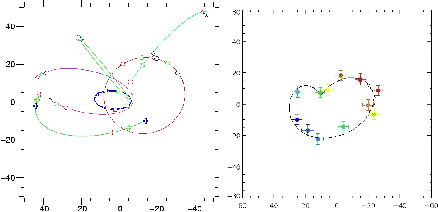The new infrared integral field spectrometer on the VLT, SINFONI, has allowed several breakthroughs in the Galactic Centre research. Among other results, it has enabled us to (1) detect for the first time OB main sequence stars that reside in two disks orbiting the supermassive Black Hole Sgr A* at the centre of the Milky Way galaxy; (2) obtain unambiguous Keplerian orbits for the S-stars, which orbit the black hole in the central arcsecond, reaching velocities of thousands of kilometres per second; and (3) determine the spectral energy distribution of the energetic outbursts (flares) of Sgr A*.
We want
to thank Pierre Léna for his early involvement in the instrumental
project that is the natural follow-up to SINFONI and will undoubtedly
bring the next lot of breakthroughs: GRAVITY. The imaging capabilities
of this second generation instrument for the Very Large Telescope
Interferometer will give us the opportunity to trace the orbits of
stars even closer to the black hole, for which relativistic precession
will be detectable within a couple of orbital periods (of the order of
one year!). Furthermore, this instrument will have an astrometric
accuracy of ![]() as (microarcseconds), equivalent to the angular
length of one Schwarzschild radius of the central black hole. By
resolving the path of the centroid of Sgr A*'s flares, we will be able
to probe the space-time close to the event horizon of the supermassive
black hole.
as (microarcseconds), equivalent to the angular
length of one Schwarzschild radius of the central black hole. By
resolving the path of the centroid of Sgr A*'s flares, we will be able
to probe the space-time close to the event horizon of the supermassive
black hole.
Left panel below: simulation of 15 months of GRAVITY observations of the central 100 mas of the Galaxy. Several of the stars have completed at least one orbit and show detectable relativistic precession (axes are in milliarseconds). Right panel: we have modeled flares in Sgr A* as a hot spot on the innermost stable orbit of a Schwarzschild black hole, and simulated astrometric observations of the object. The complex structure of the apparent path of the centroid reveals relativistic effects (strong lensing, beaming...). Axes are in microarcseconds. Ten simulated flares co-added.
